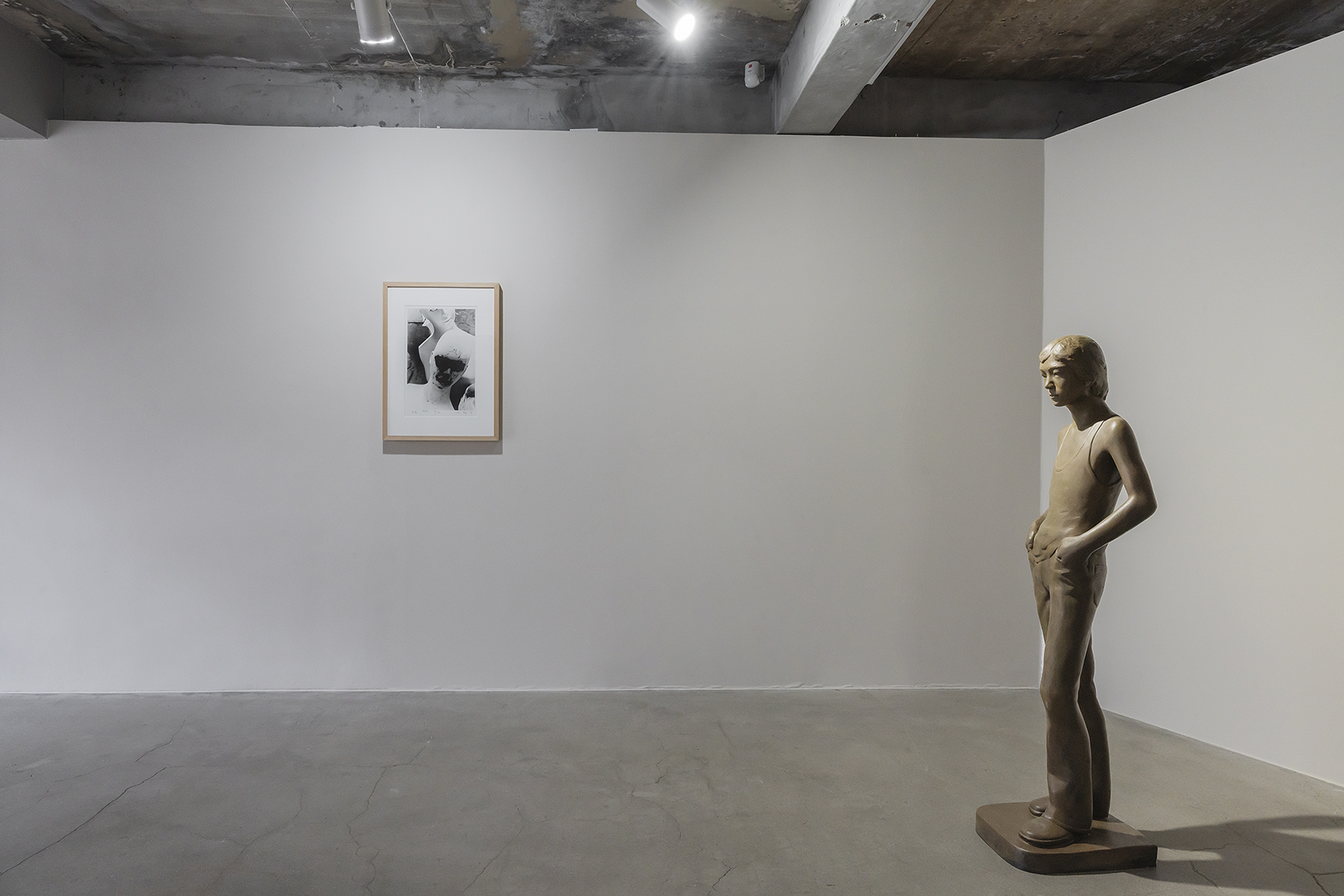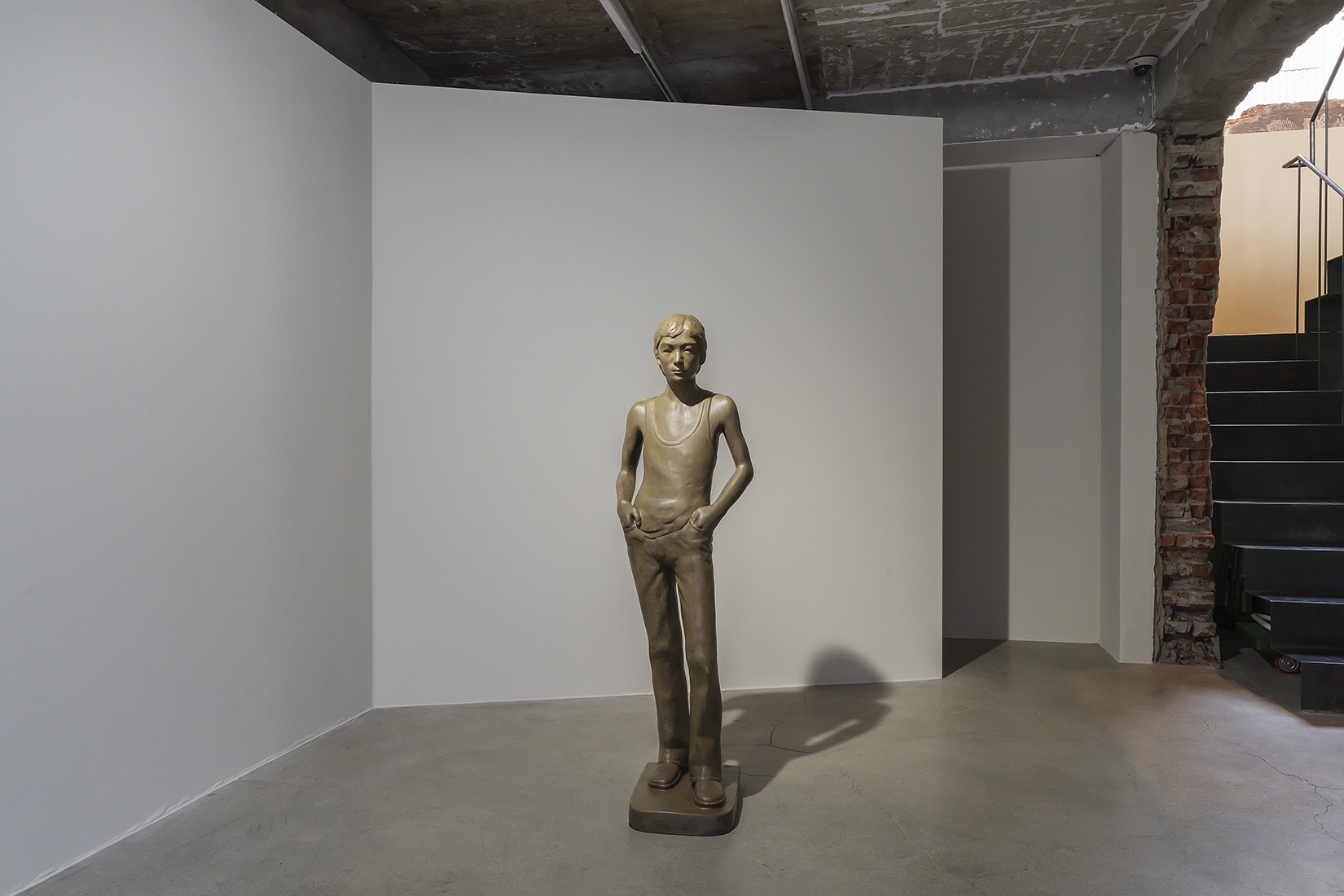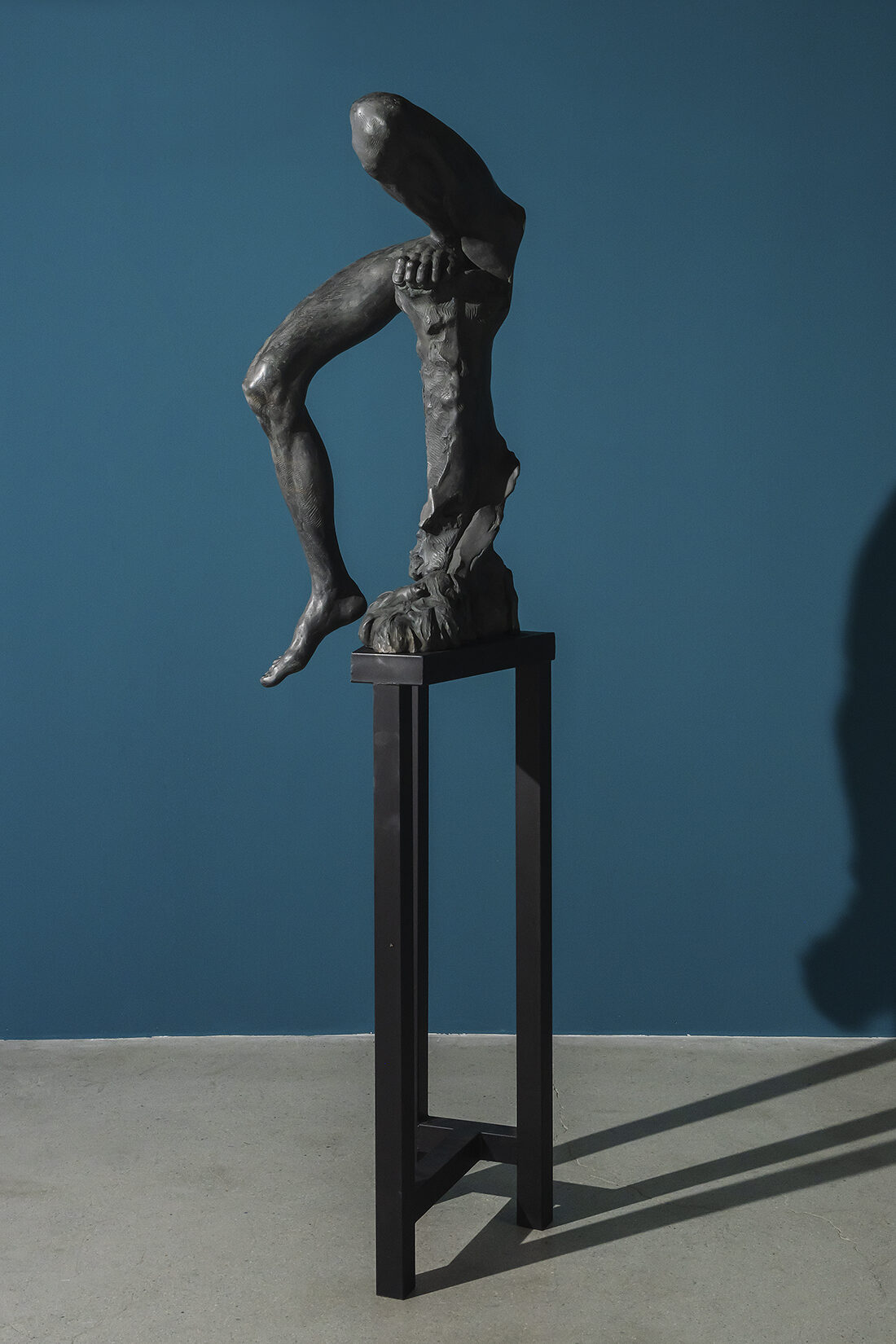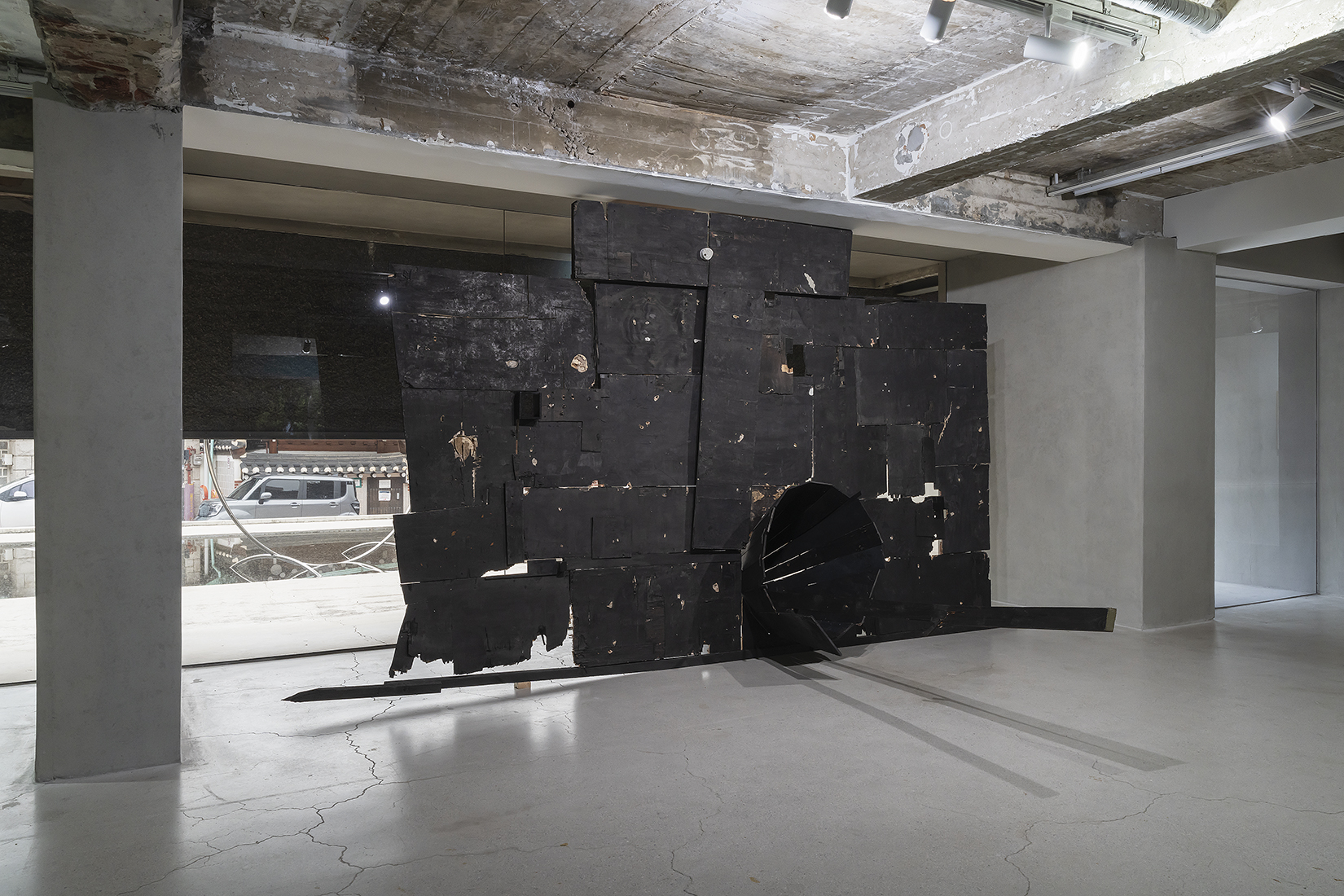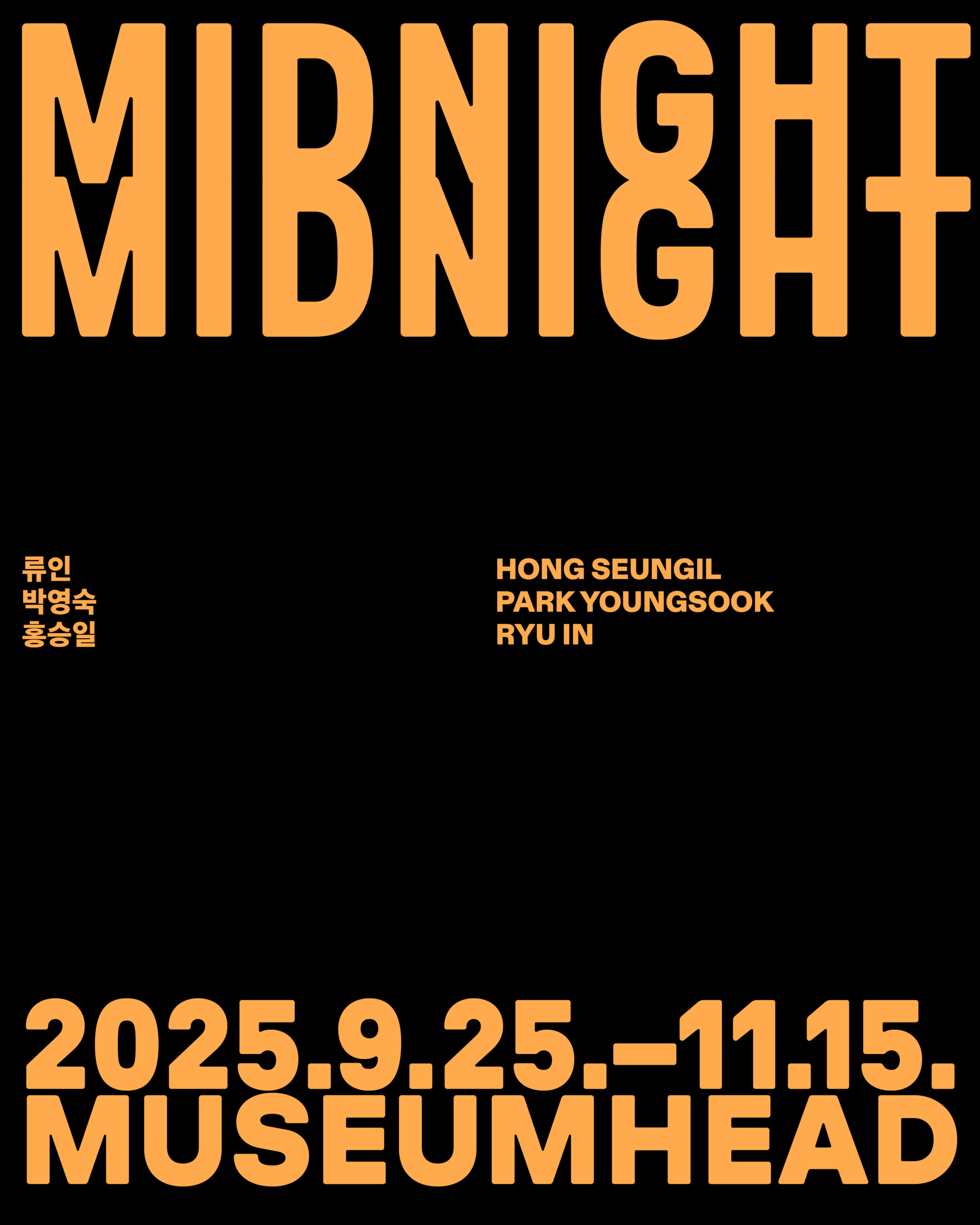《미드나잇 미드나잇》
류인 박영숙 홍승일
25.09.25.-11.15.
12:00-19:00 (일, 월 휴관)
기획: 권혁규
협력기획 및 진행: 허호정, 박세연
그래픽 디자인: A Studio A (이재환)
테크니션: 플라우만워커스 (김병찬), 도트네조각실 (김태현)
주최, 주관: 뮤지엄헤드
후원: 한국문화예술위원회
도움: 이인혜 선생님, 아라리오뮤지엄, 아라리오갤러리
- 본 전시는 “한국문화예술위원회 2025 시각예술창작주체” 지원금의 지원을 받아 운영되었습니다.
소란스러운 날들이 지난 후, 기억에 남는 것은 무엇일까. 전시는 한바탕 소동을 증폭시키는 잡음과 한철 모략을 넘어, 온전히 오늘을 마주하는 장면으로 존재할 수 있을까. 잠깐의 멈춤도 허락하지 않는 성급한 모색의 스타일을, 과잉된 스크린과 억지 경험을 거슬러 오늘을 더 견고하게, 또 집요하게 붙잡아 볼 순 없을까.
《미드나잇 미드나잇》은 시간을 겹쳐본다. 멀다, 관계없다, 미약하다 여겨지는 서로 다른 시간들을 지금-여기, 오늘에 포개어 본다. 어느 날의 젊음과 무모함, 미완의 시도들, 이미 보았다고 믿어지는, 또 결코 도달할 수 없으리라 여겨지는 장면들이 모여든다. 여기 모인 장면들은 억지 미래를 약속하거나, 과거의 유산을 앞세우는 대신 탈색된 시간과 장소 속에서도 여전히 생성되는 순간의 연쇄를 기대한다. 그렇게 전시는 지난 것과 오지 않은 것을 겹쳐 보이는 오늘의 비약적 접속을 그려본다. 그날의 번쩍임이 연대기적 흐름 속에서 영웅담이 되거나, 과도기의 미미한 실험 정도로 정리되지도 않고, 현재로 이어진다고, 시간들은 중첩되고 지속된다고 믿고 싶은지도 모른다. 협찬과 후원 로고로 가득한 밤이 동시대의 시간성을 압도하는 와중에도 여전히 움트는 다른 시간과 장면이 목격되길 바라면서 말이다. 전시는 소란스런 그날, 눈에 띄지 않았던 움직임, 지나치며 놓쳤던 표정이나 단어들, 잠시의 침묵을 더듬으며 서로 다른 시간들을 엮어본다. 공허한 파티를 벗어난 한밤중의 고군분투를 오늘로 이어보는 직감을 의도한다.
《미드나잇 미드나잇》은 오늘을 붙잡는 중첩의 시간으로 1980년대로부터 전개되는 몇몇 역사적 지점을 소환한다. 류인, 박영숙, 홍승일의 활동이 겹치는 이 시기는 말 그대로 정치 ·경제·사회 전반의 격변기였다. 1980년대는 신군부의 비상계엄으로 시작해, 민주화 운동과 경제 고도성장이 교차하고 있었다. 1986년 아시안게임과 1988년 서울올림픽을 계기로 해외 교류가 확장되고 문화 환경도 급변했으며, 미술계 또한 제도적 팽창과 경제 활성화를 통해 그 외연을 넓혀갔다. 한편, 당시 많은 젊은 작가들은 이 같은 흐름에 동일한 논리로 무조건 가담하기보다, 소그룹 활동이나 개인적 관심사를 매개로 한 집약적 실천을 전개하며 차별적 위치를 탐색했다. 결과적으로 1980년대 한국 미술은 제도적·현실적 조건의 변화 속에서 이전보다 다양한 양상을 띠게 되었으나, 미술사 서술에서는 주로 1970년대의 단색화·추상 일변도와 대비되는 리얼리즘 혹은 ‘민중미술’의 흐름으로 수렴·요약되곤 한다. 이어 1990년대 폭발적인 산업화와 더불어 다매체적이고 탈전통적인 미술의 경향은 신세대·포스트모던 미술의 전유물로 이해되었고, 그 결과 1980년대에 (이미) 존재했던 설치, 레디메이드 오브제, 페미니즘 미술, 수행적 행위 예술 등 다양한 실천들은 충분히 조명되지 못한 채 부차적인 수준으로 밀려났다.
그리고 어떤 오늘은 이와 기묘한 평행을 이루는 듯하다. 한밤중의 비상계엄, 해결되지 않은 사회적 혼란들, 현대미술을 정치적·경제적 장치로 활용하고 과시하는 듯한 해외 교류 행사들, 자본과 제도의 상호작용을 매개로 미술계의 구조와 가치 체계를 재편하는 글로벌 시장 플랫폼, 이러한 확장 속에서 포착되지 않은 채 배제되는 미술과 경험들, 다시 숙제로 남는 연구와 비평, 그리고 전시의 과제들까지.
그동안 한국 현대 미술에서 ‘현대성’ 혹은 ‘동시대성’은 어떻게 규정되고 또 규명되어 왔는가? 편년체의 역사 서술 속에서 현대의 시급성, 동시대의 갈급함은 과거와의 단절, 분명한 혁신의 계기를 소환해왔고, 역사는 그렇게 메워지지 않는 틈을 남겨두었다. 1970년대의 단색화 계열과 1980년대 민중미술 사이, 1980년대 후반의 페미니즘 운동과 ‘여성미술’ 사이, 1990년대 전후의 전지구적 ‘포스트 모더니즘’ 현상과 그 이전의 한국 미술 사이 등. 특정한 조류가 불거질 때 그에 포섭되지 않는 복수의 시도들은 인과 관계를 뒷받침하는 이행기, 과도기, 불가피한 분절의 파생 산물 정도로 이해되었다. 역사적 분기점의 틈바구니에 위치한 시공간은 그렇게 일종의 공백으로 남겨져, 산재한 질문을 품은 채 오늘을 맞는다. 그리고 그 오늘은 반복된다. 전시는 이처럼 틈새에 존재하는 움직임들을 내재적인 연속성 속에서 복기하며, 새로움과 시급함, 부흥의 언어가 미처 다 포착하지 못했던 그날의 동력을 다시 확인하려 한다. 그때를 오늘 이곳에 다시 불러내고 또 겹쳐보며 현재의 증상, 공백을 감각하고 또 채워보려 한다.
류인(1956-1999)의 조각은 주로 ‘형상조각’으로 설명되어 왔다. 여기서 ‘형상’은, 추상 또는 구상(사실주의) 등에 대별해 특히 1980년대 조각의 새로운 경향을 가리키며 등장한 용어였다.[1] 1980년대 민전[2]은 아카데미즘적 구상화 혹은 추상적 모더니즘의 옹호에서 벗어나 신형상 · 신구상, 나아가 비판적 리얼리즘이라 불리는 미술로의 전환에 가세했고, 이를 배경으로 국내 미술계에 ‘형상성’ 담론이 자리 잡게 된다. 형상성은 말 그대로 회화 및 조각에서 추상적 화면이 아닌 ‘형상’을 드러낸다는 의미였기에 하이퍼리얼리즘, 초현실주의, 표현주의, 고전적인 사실주의 등 다양한 양식으로 발현될 수 있었다.[3] 그런 한편, 이른바 ‘민중’ 계열은 비판적 리얼리즘 양식으로서의 형상과 그렇지 않은 것을 구분하는 기준을 점점 더 구체화하게 되었다.[4] 이와 함께 자리한 ‘추상 대 형상’, 혹은 ‘구상 대 형상’의 개념적 대립은 조각의 한국성 또는 현대성 등을 정의하려는 역사 서술 과정에서 의도적으로 도입된 도식에 가까워졌다. 개별 작품의 조형 양상은 실제로 매우 복합적인 맥락에 놓여 있었음에도 말이다.[5]
전시에 포함된 류인의 작업은 사실적이라고 단정하기엔 과장된, 추상적이라기엔 구체적인 그만의 특징적인 인체 형상을 드러낸다. 전시장 입구에 자리한 초기작 〈자소상〉(1980)[6]부터 내부의 〈입산 I〉(1986), 〈망각의 그늘〉(1993) 등 대략 10여 년에 걸쳐 제작된 조각들은, 정돈된 사실적 조각에서 극도의 긴장 상태를 구현하는 신체 변형에 이르기까지 다양한 작업의 궤적을 펼쳐 보인다. 특히 작가는 인간 실존의 고통과 한계를 표현하듯 신체를 왜곡, 과장, 변형하는 한편 입방체, 원기둥, 원형의 고리 등과 같은 기하학적이고 추상적인 지지대를 작업의 일부로서 포함시킨다.[7] 그렇게 형상조각으로 불리는 작업에는 세부의 사실적 묘사와 물리적 조건/구조들이 대립적인 요소의 충돌 속에 극적인 긴장감을 만들어낸다. 원형의 파이프 위에 인체가 뉘어(꽂혀) 있고, 물리적 덩어리의 파편 같은 신체는 과도하게 꺾이거나 비틀어지는가 하면, 한쪽으로 치우쳐 드라마틱한 동세를 만들기도 한다. 류인의 작업에서 ‘몸’ 그리고 ‘형상’은 단순한 재현 대상으로 자리하지 않는다. 그것은 단순히 외부 세계를 모사하는 도상적 기호로 환원되지 않으며, 유기적 생체를 넘어 때로는 비유기적이고 기계적인 성격을 띠기도 한다. 그렇게 개인의 심리와 정서를 매개하면서 동시에 조각적 형식 자체를 탐구하고 재구축하는 중심축으로 자리한다. 전시는 류인 작업에 나타난 인체가 1980년대 한국 조각의 ‘형상성’ 담론을 단순히 복구하거나 상징하는 차원에 머물지 않음을, 오히려 조각 내부에서 조형적 사유와 실험을 매개하며 형상성과 추상, 재현과 조형이라는 이분법적 구도를 넘어서는 가능성으로 작동하였음을 상기시킨다.
박영숙(1941-2025)은 페미니즘적 시선을 견지하며 사진 매체를 탐구해왔다. 여기서 페미니즘적 시선이란, 사진에서 빚어지는 ‘찍는 자-찍히는 자-보는 자’의 관계를 위계로부터 해방하고 또 연대하도록 만드는 태도를 가리킬 것이다. 일반적으로 한국 페미니즘 미술의 기점은 1980년대로 설정되지만,[8] 박영숙의 사진을 논할 때 이 시간적 범위는, 그 의미와 영향은 좀 더 확장된다. 일례로, 1966년 중앙공보관에서 열린 박영숙의 첫 개인전은 당시 ‘여성’ 사진가의 유일한 개인전 사례로 기록된다. 해당 전시에서 작가는 교양 잡지 『여상』의 기자로 재직하며 촬영한 여성 모델들의 사진을 공개하였다.[9] 전시에 포함된 흑백 사진 〈장면 13〉은 이 시기 박영숙 작업의 특성을 가늠하게 한다. 흑백 대비 속에서 칠이 벗겨진 마네킹의 얼굴은 시대적 균열을 요청하는 듯하다.
이후 작가는 1980-90년대를 지나며 그만의 조형성과 함께, 연극적이라 할 사진들을 적극 탐구한다. 대표적으로 〈미친년 프로젝트〉에서 작가는 사회적으로 구성된 ‘여성 신체’, ‘여성성’ 내의 광기를 포착했다. 해당 프로젝트는 《99 여성미술제: 팥쥐들의 행진》에서 처음 선보인 이래, 〈갇힌 몸 정처 없는 마음〉(2002), 〈오사카와 도쿄의 페미니스트들〉(2004), 〈꽃이 그녀를 흔들다〉(2005) 등의 시리즈로 확장, 구체화되었다. 위 시리즈를 비롯해 작가는 또 다른 프로젝트를 통해 ‘만드는’ 사진과 ‘찍는’ 사진의 대립적 구도를 재고했다. 작가는 연출과 포착, 필연과 우연, 조작과 자연, 구조와 개인 등의 개념적 대립쌍을 질문하고 그 경계를 흐리는 작업을 지속하는데, 최근 작업 〈그림자의 눈물〉(2019~)에서는 그간 사진의 중심에 놓였던 인물들 대신 유령처럼 흩날리는 사물과 그 흔적, 장소, 분위기를 담는 데 주력한다. 활화산, 이끼, 넝쿨이 무성한 제주의 곶자왈에서 촬영한 〈그림자의 눈물 #12〉는 그간의 사진이 보여 온 기다림과 포착의 감각과는 다른, 그 자체로 대상이 목소리를 내기를 허락하는 확장과 포용의 태도를 환기한다. 전시는 오늘날 단편적으로 소개되는 페미니즘 미술과 사진의 확장을 재고하며, 박영숙 사진의 대상, 연극적 요소, 그리고 페미니즘적 가치를 궁극적으로 활성화하려는 최근의 태도까지, 긴 시간 동안 이어져 온 작가의 실천을 살펴본다.
홍승일(b.1960)은 이른바 ‘80년대 소그룹 운동’[10] 중 하나인 ‘메타복스’[11]의 일원이었다. ‘메타복스’라는 이름은 넘어섬을 의미하는 ‘메타(Meta)’와 목소리 또는 발언을 뜻하는 ‘복스(Vox)’를 결합한 것으로, 당시 화단의 제도권 내 모더니즘 미학을 극복하고 다양한 목소리를 회복하려는 방향성을 담아 지어졌다. 1980년대 중반은 한국 현대미술의 “무의미한 자기복제”[12]를 반성하고, “주변과 호흡하며”[13], “개념화되고 익명화된 물성을 극복”[14]하고자 <타라TA-RA>, <난지도>, <메타복스>와 같은 소집단이 결성되던 시기였다. 이들 ‘소그룹 운동’은, 대부분 오래 지속되지 않았던 탓에 1990년대 ‘포스트-모던 미술’의 배경 내지는 예비적 증후로 이해되거나, 미완의 매체 실험으로 간주되곤 했다. 전시는 이 움직임을 미술 제도의 균열과 불안정성을 드러내는 현재적 현장으로 재맥락화한다. 단순히 이후 세대의 등장을 설명하는 징검다리나 일시적 에피소드, 미완의 시도로 축소하지 않고, 내부 관습을 교란하며 새로운 실천적 언어를 실험한 구체적 계기로서, 1980년대 후반에서 1990년대 초반 한국 미술 속 동시대성의 전개를 보여주는 증언적 장면으로 읽어 본다. 이를 통해 오늘날 누락된, 경계의 실험적 움직임, 제도와 개인, 집단과 매체의 관계를 다시금 사고하고자 한다.
1980년대 중후반, 홍승일은 ‘사물’의 직접성을 강조하며, 설치라는 개념이 명확히 정립되지 않았던 시기에 장소특정적이고 다매체적인 작업을 주로 선보였다. 그는 일상적으로 변화하는 도시의 풍경을 마주하며, 도심 곳곳 공사장에서 수집한 오염되고 갈라진 폐합판을 활용해 백색의 전시 공간을 점유하는 대형 설치 작업을 선보이기도 했다. 이번 전시작은 그가 1996년 미술회관(현 아르코미술관) 작가 공모에 선정되어 발표한 《죽은 갯벌과 황폐한 영혼》과 맞닿는다.[15] 긴 시간을 지나 겨우 구조체에 기대어 선, 이 작업은 완성된 형태보다는 오브제의 임시성과 자연 소멸/발생적인 변형을 선택한다. 작업은 그때나 지금이나 여전히 공사 중인 도심을, 팽창하는 외연 속 상실된 내용을, 재편되는 동시대 미술 속에서 방향을 잃은 실험의 의지를 마치 데자뷰처럼 떠올리게 한다. 동시에, 안착하기보다 끊임없이 해체되고 재조립되는 과정을 통해 오늘 미술의 불확실성과 가능성을 함께 드러낸다. 전시는 홍승일의 작업과 함께 1980년대 실천의 동시대적 유사성을 확인하며, ‘소그룹 운동의 지속’이라는 가정형 문장을 오늘의 맥락에서 현행화한다.
현재는 나아지지 않을 것이다. 다만 벗어나려 할 뿐이다. 벗어남이 곧 현재라면, 전시는 그 현재를 여러 시간에 겹쳐보며 상상한다. 전시에 모여든 장면들에는 쉽게 타협하거나 한쪽으로 치우치지 않는, 미약한 가능성으로라도 상황을 돌파하려는, 결코 종결되지 않는 그만의 벗어남이 있다. 단지 ‘젊은’ 공간으로 여겨지며 착각되고 무마되는, 또 엉뚱하게 오해되는 이곳 전시장에는 미완의 성취와 함께 좌절과 분노, 방향을 읽은 속도와 허망함, 그리고 불신이 뒤섞여 있다. 미결의 지속과 벗어남 속에서, 전시는 하나의 납작한 사건으로 환원되지 않는, 시간의 결이 흔적처럼 드러나고 교차하는 장면들을 의도한다. 그리고 이탈하는 움직임의 배경을 관찰하며, 오늘의 상실에 이정표가 될 어떤 힌트를 얻을 수 있을지 기대해본다. 세 작가의 그날이 오늘 필요한 시간은 아닌지 질문하며, 이들을 한 명의 작가로 상정해보기도, 각자의 시간이 오늘과 어떻게 연결될 수 있는지 탐색해보기도 한다. 가히 영화적이라 할 이 망상을 통해, 동의할 수 없는 가치들로 재편되는 동시대 미술에서 쉽게 드러나지 않는 무언가를 유심히 바라보려 한다. 질주하는 시간을 잠시 멈춰 놓고 다시 플레이하며, 놓친 장면들이 무엇인지, 또 필요한 건 무엇인지 가늠해본다. 비록 그 시도가 매번 어긋나고 마는 나선형의 통로를 지날지라도, 그렇게라도 현재를 다시 묻는다. 결국, 나아지지 않는 현재의 엔터테인먼트에는 늘 우울과 탈주가 함께한다.
기획/글 권혁규
[1] 관련 연구로는 다음을 참고. 류다움, 「1980년대 한국 형상조각 연구: 인간 조각을 중심으로」, 『미술사학보』 51 (2018).
[2] 일제 치하 미술 제도였던 ‘조선미술전람회’의 틀을 이어받아 1949년 이후 유지된 국가 유일의 미술 정책 ‘대한민국미술전람회’(국전)의 폐단이 곳곳에서 지적되었다. 이에 반발하는 젊은 작가들의 항의가 1960년(이른바 벽전) 이래 지속된 가운데, 1978년 민간에서 언론사를 중심으로 조직한 미술 제도를 ‘민전’이라 부른다. 그 성격의 복잡함에 관해선 다음을 참고. 심정원, 「1970년대와 민전 – ‘민전시대’의 개막과 그 성격」, 『기초조형학연구』 15 (2014).
[3] “평단 일각에서는 80년대에 일어난 이런 현상을 혁신적인 문화운동으로 보려는 조짐도 보인다. 한쪽에선 이들의 작업을 ‘신형상’또는 ‘새로운 구상회화’로 부르며 민족미술, 민중미술운동으로 정의하기도 한다.” 정중헌, 「쟁점 80년대 미술운동」, 『조선일보』(1984.8.30). 다음에서 재인용: 서유리, 「중앙미술대전과 신형상회화: 한국 미술장의 변동 (1978-1989)」, 『미술사학보』 64 (2025).
[4] ‘형상’ 어휘의 모호함과 이를 둘러싼 논쟁의 양상은 다음의 연구를 통해 확인. 기혜경, 「서울미술관 전시와 80년대 형상미술의 전개」, 『미술문화연구』 29 (2024).
[5] 홍지석, 「조각의 근대성과 현대성: 한국근현대조각사 서술의 쟁점들」, 『한국근현대미술사학』 46 (2023).
[6] 류인의 동료 조각가 오상일은 이 작품이 류인의 최초 작업이라고 회고한다: 『류인: 파란에서 부활로』 (소마미술관, 2020), 73.
[7] 류인 조각의 입방체, 추상성의 면모에 관한 해석은 다음을 참고. 최태만, 「류인 작품의 격정성과 추상충동 재고」, 『인물미술사학』 15 (2019); 김종길, 「류인의 형상조각 연구: 입방체의 현실리얼리티 분석과 형상조각론」, 『인물미술사학』 6 (2010).
[8] 관련 논의에 관한 개괄은 다음을 참고. 허호정, 「페미니즘, 큐레이팅, 역사 쓰기: 1. 큐레이터의 딜레마」, 『MMCA Research Lab』 주제연구 1 (2023): https://www.mmcaresearch.kr/essays/view.do?fid=880.
[9] 박영숙 작가의 작업 세계 전반에 관한 매체 탐구적 접근은 다음을 참고. 이슬비, 「매체 탐구로 구현된 박영숙의 페미니스트 사진」, 『한국근현대미술사학』 46 (2023).
[10] 이은수, 「1980년대 소그룹 난지도와 메타복스의 설치미술: 표현매체로서의 물성, 그리고 현실과 전통」, 『한국근현대미술사학』 46 (2023).
[11] 메타복스는 홍승일을 비롯해 홍익대 대학원 서양화과 동기였던 김찬동, 오상길, 안원찬, 하민수가 모여 1985년에 창립한 단체로, 다섯 차례의 단체전 후 1989년 해체했다.
[12 김장섭, 타라 창립전(1981. 5) 브로슈어 서문 중.
[13] 난지도 창립전(1985. 2) 카탈로그 중.
[14] 이일, 메타복스 창립전(1985. 9) 카탈로그 서문 중.
[15] 미술회관 작가 공모에 관해선 작가의 말을 참고. 당시 전시의 리뷰는 다음에서 찾아볼 수 있다. 양건열, 「작가를 찾아서 – 어둠의 마을 /홍승일」, 『미술세계』 138 (1996년 5월).
𝑀𝑖𝑑𝑛𝑖𝑔ℎ𝑡 𝑀𝑖𝑑𝑛𝑖𝑔ℎ𝑡
RYU In, PARK Youngsook, HONG Seungil
Curated by KWON Hyukgue
Curatorial Team: HUR Hojeong, BAC Seyon
Graphic Design: A Studio A (LEE Jaehwan)
Technical Support: Ploughman Workers (KIM Byungchan), Dot Sculpture Studio (KIM Taehyun)
Hosted and Organised by Museumhead
Supported by Arts Council Korea
Special thanks to LEE Inhye, Arario Museum, Arario Gallery
After noisy days have passed, what remains to be remembered. Can an exhibition exist as a scene that confronts the present day, beyond the noise and the seasonal insinuations that amplify the commotion? Can’t we hold on to the present day more firmly and tenaciously, against the excess of screens and forced experiences and a style of impetuous searching that does not allow a moment to pause?
Midnight Midnight overlaps time. Folds the Moments once thought distant, irrelevant, or faint into here-and-now, today. The youthfulness and recklessness of a single day, the unfinished attempts, the scenes believed to be seen, and the scenes believed to be unattainable are gathered. They do not promise a future, nor do they foreground the legacy of the past. But rather anticipate the chain of moments that are still being generated in a faded time and place. The exhibition sketches a leap connection of today, superimposing the past and the yet to come. It may be tempting to believe that the flashes of the day do not become heroic stories in a chronological flow, nor are they organized as marginal experiments in transition, but lead to the present, that time overlaps and persists. While the nights filled with sponsorships and sponsor logos are overwhelming the temporality of contemporary, one still hopes other times and scenes that are sprouting to be witnessed. The exhibition weaves different times together, groping unnoticed movements, overlooked expressions or words, moments of silence in that noisy day. It intends an intuition that the midnight struggle which escaped out of the hollow party leads to the present.
Midnight Midnight summons several historical points from the 1980s as a time of overlap holding onto today. The period in which RYU In, PARK Youngsook, HONG Seungil’s activities overlap was literally a time of political, economic, and social upheaval. The 1980s began with emergency martial law under the new military rulers and was marked by the intersection of democratization movements and high economic growth. International exchange expanded after the 1986 Asian Games and the 1988 Seoul Olympics, transforming the cultural environment. Within the art world, institutional expansion and market activation widened its scope. Yet many young artists sought positions apart from this flow, working through small groups or personal interests to build distinctive actions. As a result, Korean art in the 1980s took on more diverse forms than before through institutional and realistic conditions. But art historical narratives often converge and summarize them as realism or ‘folk art’ that contrasts with the monochromatic and abstract uniformity of the 1970s. And after the explosion of industrialization in the 1990s, multimedia and non-traditional art were understood to be the preserve of new and postmodern art. As a result, various practices that were (already) present in the 1980s such as installations, ready-made objects, feminist art, and performance art, were relegated to a secondary level without being sufficiently featured.
And some days in the present seem to have an odd parallel with those. The midnight state of emergency martial law, unresolved social turmoil, oversea exchange events that seem to utilize and flaunt contemporary art as a political and economic device, global market platforms that reshape the structure and value system of the art world through the interplay of capital and institutions, art and experiences that are excluded in this expansion not being captured, and the challenges of research, criticism, exhibition.
How has ‘modernity’ or ‘contemporaneity’ been defined and characterized in Korean contemporary art? In the depiction of chronological history, the urgency of the present, the thirst for the contemporary has invoked a break with the past, a clear moment of innovation and left a gap in history that cannot be filled. Between the monochrome tendencies in the 1970s and the folk in the 1980s, between the feminist movements of the late 1980s and the category of “women’s art,” between the global ‘post-modernism’ in the 1990s, Korean art before that, and so on. The multiple attempts that did not fall under its sway When a particular current emerged were understood merely as transitional, interstitial, and inevitable products that supported the causality. The times and spaces caught between historical turning points were left as voids, carrying unanswered questions, and moving on to the present. And it continues. The exhibition seeks to revisit the movements that exist in between, tracing them through their immanent continuities. It aims to rediscover the energies of that day, what the language of novelty, urgency, and revival once failed to fully capture. By calling that moment back and overlapping with the present, it attempts to sense and fill the symptom, the void it has.
RYU In’s (1959-1999) sculptures have been described as “figurative sculpture.” “Figuration” is a term that emerged to refer to a new trend in sculpture especially in the 1800s, whether abstract or figurative (realism).[i] In the 1980s, Minjeon[ii] broke away from the advocacy of academical figuration or abstract modernism and joined the transition to new figuration, nouvelle figuration, and even critical realism. This established the discourse of ‘figuration’ in the Korean art world. As figuration literally means to reveal ‘shapes’ in paintings and sculptures, rather than abstractions, it was able to be revealed into hyperrealism, surrealism, expressionism, classical realism.[iii] Meanwhile, the public could concretize the standard of sorting the form of what is critical realism or not.[iv] The conceptual opposition of “abstraction versus figuration,” or “representation versus figuration,” which emerged at that time, became close to an intentional schema to define Korean sculpture’s national character or modernity.[v]
However, the sculptural aspects of individual works were placed in far more complex contexts. RYU’s works in the exhibition reveal his characteristic human figures that are too exaggerated to be realistic, too concrete to be abstract. From his early work Self-Portrait (1980)[vi] at the entrance, to Entering the Mountains (1986) and In the Shade of Oblivion (1993) which span about a decade, the sculptures unfold a diversal trace from ordered realism to deformations charged with extreme tension on a human body. The artist especially puts the geometric and abstract sustainer like a cube, cylinder, circular ring as a part of his work, just like verifying the suffering and limit of human existence.[vii] These figurative sculptures create dramatic intensity inside the clash of realistic depiction in details and physical conditions/structures. The human body is stretched over a circular pipe, and the body, like a fragment of a physical mass, is excessively bent or twisted, or even lean to one side creating a dramatic pose. In RYU’s work, “body” and “figure” do not stand as objects just for representation. They are not reduced as iconic symbols that merely imitate the external world, but rather take on as an inorganic and mechanical character beyond organic living structure. As such, it becomes a central axis for exploring and reconstructing the sculptural form itself while mediating the psychology and emotions of the individual. The exhibition reminds us that the human body in RYU’’s work does not merely restore or symbolize the ‘figurative’ discourse in the 1980s Korean sculpture, but rather mediates sculptural thought and experimentation within the sculpture, operating as a possibility beyond the dichotomies of figuration and abstraction, representation, and molding.
PARK Youngsook (1941-2025) has been exploring the medium of photography while maintaining a feminist perspective. By feminist perspective here, it refers to an attitude that liberates the relationship between “the photographer – the photographed subject – the viewer” from hierarchy and builds solidarity. Usually, the starting point of Korean feminist art is set in the 1980s[viii] but in discussing Park Young-sook’s photography this temporal scope is extended in its meaning and impact. For example, Park’s first solo exhibition at the Central Public Information center in 1966 is recorded as the only solo exhibition by a female photographer at the time. In this exhibition, PARK presented photographs of female models while working as a journalist for the cultural magazine called Woman.[ix] The black-and-white photograph Scene 13, included in the exhibition, gives an impression of the characteristics of PARK’s work during this period. Within the sharp contrast of black and white, the paint which peeled off on a mannequin’s face seems to demand a crack in the era.
From the 1980s and 1990s, the artist actively explored photographs that are theatrical with her own unique formative style. For example, in the Mad Woman Project, she captured the madness within the socially constructed female body and femininity. The project was first presented at the 99 Women’s Art Festival: Patjis on Parade, and since then it expanded and refined into series such as Imprisoned Body, Wandering Spirit #1(2002), Feminists in Osaka and Tokyo (2004), and A Flower Shakes Her (2005). Through these and other projects, PARK reconsidered the oppositional framework between “making” and “taking” photographs. She continues to question and blur the boundaries between conceptual pairs of opposites, such as direction and observation, inevitability and chance, manipulation and nature, structure, and individuality. In her latest work, Tears of a Shadows (2019-), she focuses on capturing ghostly objects, their traces, places, and atmospheres instead of the human figures that long occupied the center of her photographs. Tears of Shadow #12, shot in Jeju’s Gotjawal, a landscape of active volcanoes, moss, and vines evokes an attitude of expansion and embrace that departs from the sense of waiting and capturing seen in previous photographs. Instead, it allows the subject itself to speak. The exhibition reconsiders the expansion of feminist art and photography which is often presented in fragments today. It also emphasizes the object, theatricality of Park’s photographs, examines her practice over a long period of time, including her recent attitude to ultimately activate feminist values.
Hong Seung-il (b.1960) was a member of Metavox[x], one of the small group movements of the 80s[xi]. The name ‘Metavox’ combines the words “meta,” meaning overcoming, and “vox,” meaning voice or utterance. It refers to the group’s goal which is to overcome the modernist aesthetic within the institutionalized art world of the time and recover diverse voices. The mid 1980s was a time reflecting on the “meaningless self-replication”[xii] of Korean contemporary art, “breathe with the surroundings”[xiii] and to “overcome the conceptualized and anonymized materiality.”[xiv] This was the time when small collectives such as TA-RA, Nanjido, and Metavox were formed. These “small group movements” are often understood as preliminary symptoms within the background of the post-modern art of the 1990s, or as unfinished experiments with the medium because most did not last long. The exhibition recontextualizes this movement as a present site that exposes the cracks and instability of the art system. Rather than simply reducing it to a tipping point, a transitory episode, or an unfinished experiment that explains the emergence of the subsequent generations, it reads as a testimonial scene that reveals the development of contemporaneity in Korean art from the late 1980s to the early 1990s, a concrete moment that disrupted internal conventions and experimented new practical languages. Through this, it seeks to reconsider the experimental movements at the boundaries, as well as the relationships between institution and individual, collective, and medium which is omitted nowadays.
In the mid late 1980s, Hong emphasized the directness of ‘things’ and presented site specific and multimedia works at a time when the concept of installation was not clearly defined. Facing the daily changing urban landscape, he created large scale installations that occupied white exhibition spaces using contaminated, cracked, and discarded plates collected from construction sites around the city. This exhibition meets up with “Dead Gulls and Desolate Spirits,” which he presented in 1996 after being selected for an artist call at the Art Center (now Arko Museum of Art)[xv]. Leaning against the structure after a long period of time, the work chooses the temporality of the object and its natural disappearance/evolutionary transformation rather than its finished form. The work evokes the will of experiment in the reorganizing of contemporary art, which is wandering, like a Deja vu. And at the same time, it evokes the uncertainty and possibility of art today through the process of constant deconstruction and reassembly rather than settling down. The exhibition makes the hypothetical sentence ‘Continuation of the small group movement’ current in today’s context, confirming the contemporary parallels of the 1980s practice with Hong’s work.
The present will not get better. It is only trying to escape. If escape is the present, the exhibition imagines the present as overlapping across multiple moments in time. The scenes gathered in the exhibition possess an escape of sorts, one that never ends, refusing to compromise easily or lean to one side, striving to break through the situation even by the weakest possibility. This exhibition space, often misperceived and dismissed as simply a “young” space, and at times oddly misunderstood, is filled with incomplete achievements, frustration, anger, the speed of reading directions, futility, and distrust all entangled together. Within this ongoing state of incompletion and departure, the exhibition intends to stage moments where the texture of time surfaces and intersects like traces, resisting any reduction to a single, flat event. And by observing the background of the departing movement, hoping to get some hints that will mark as the loss of today. Questioning whether those days of the three artists the time is we need today, imagining them as a single artist and exploring how their time might be connected to today. Through this almost cinematic delusion, the exhibition seeks to spot the invisible in contemporary art, which is being reshaped by values that cannot be agreed upon. By pausing and replaying the racing time the exhibition tries to see what is missed and needed. Even if the attempt goes through a spiral corridor that breaks down every time, it still asks for the present again. After all, the entertainment of an unchanging present always carries melancholy and escape.
KWON Hyukgue
Chief-Curator, Museumhead
[i] For related studies, see Ryu, Dawoom “A Study of Figurative Sculpture of Korea in the 1980s: Focusing on Human Figure Sculpture,” Korean Bulletin of Art History 51 (2018).
[ii] The abolition of the “Korea Art Exhibition”(대한민국미술전람회; 국전 Kukjeon), the only national art policy maintained since 1949, which inherited the framework of the “Joseon Art Exhibition,”(조선미술전람회; 선전 Seonjeon) the art system under Japanese rule, has been pointed out in various places. While protests by young artists against this have been ongoing since 1960 (the so-called Wall Exhibition), the art system organized by the private sector in 1978, mainly by media companies, is called “Minjeon.” On the complexity of its nature, see. SHIM Jeong Won, “The 1970s and the Minjeon Exhibition-Beginning of “era of minjeon” and its characteristics,” Journal of Basic Design & Art 15 (2014).
[iii] “Some critics see this phenomenon in the 80s as a revolutionary cultural movement. Some call their work “new image” or “new figurative painting” and define it as a national art or folk-art movement.” JUNG Jung-heon, “Controversial Art Movements of the 80s,” cited in SEO Yuri “Joongang Art Exhibition and New Figuration Painting: The Change of Korean Artistic Field (1978-1989),” Korean Bulletin of Art History 64 (2025).
[iv] The ambiguity of the vocabulary of “figure” and the debates surrounding it can be seen in the following studies. KI Heygyung, “Figurative Art in the 1980s and the Exhibitions at Galerie de Séoul-Focusing on Artists in Focus,” The Journal of Art and Culture Studies 29 (2024).
[v] HONG Jisuk, “Modernity and Contemporaneity of Sculpture: Issues in the Description of Modern and Contemporary Korean Sculpture History,” Journal of Korean Modern & Contemporary Art History 46 (2023).
[vi] OH Sang-il. Ryu In: From Blue to Resurrection. (SOMA Museum of Art, 2020) 73.
[vii] For an interpretation of the cubic, abstract nature of RYU In’s sculpture, see. CHOI Tae Man, “A Reconsideration on Passion and Abstract Impulse of Ryu In’s Sculpture,” Association of Biographical Art History in Korea 15 (2019).
[viii] For an overview of related discussions, see. HUR Hojeong, “Feminism, curating, writing history: 1.Dillema of a curator,” MMCA Research Lab – TOPIC RESEARCH 1 (2023): https://www.mmcaresearch.kr/essays/view.do?fid=880.
[ix] On PARK’s medium-exploratory approach to her work, see. LEE Seul Bi, “Park Youngsook’s feminist photos embodied through media exploration,” Korean Modern and Contemporary Art History 46 (2023).
[x] LEE Eunsu, “Installation Art of the 1980s Small Groups Nanji-do and Metavox: Materiality as a Medium of Expression, and Reality and Tradition,” Korean Modern and Contemporary Art History 46 (2023).
[xi] Metavox was founded in 1985 by HONG Seung-il and his classmates from Hongik University’s Graduate School of Western Painting. KIM Changdong, OH Sang-gil, AHN Won-chan, and HA Min-soo, and disbanded in 1989 after five group exhibitions.
[xii] KIM Jangseob, from the preface of the brochure for TARA Inaugural Exhibition (May 1981).
[xiii] In the catalog for Nanjido’s Inaugural exhibition (1985.2).
[xiv] LEE Il, from the preface of the catalog for Metavox Inaugural Exhibition (September 1985).
[xv] See the artist’s remarks about the museum’s call for artists. A review of the exhibition can be found in the following. YANG Geon-yeol, “In Search of the Artist – The Village of Darkness /Hong Seungil”, Art world 138 ( 1996.5 ).




